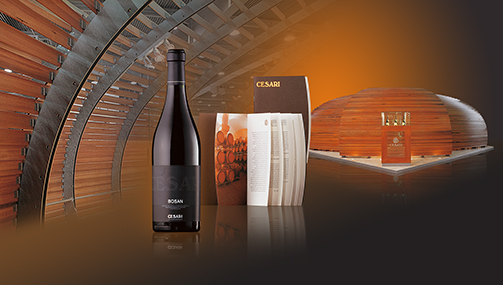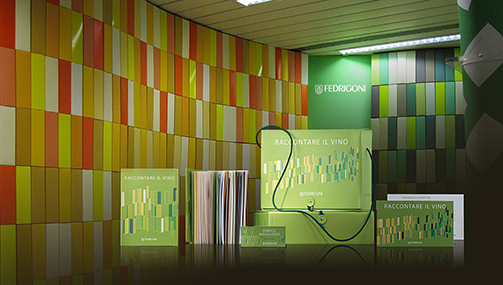Beyond the company, the stand
Reaching out from the company, going beyond, is a must.
Taking brand value into a physical space, with a formal, comprehensible language, pursuing that long-awaited sense of surprise and involvement that typifies the visitors to a trade fair.
This is about finding the correlation between “inside and outside”, that is, the relationship between the company and what is beyond it, in favour of the architecture of performance, without degrading and smothering the product.
This is a form of architecture characterised by impermanence (unlike a building that is designed to last forever), flexibility, use of suitable materials to sustain and amplify the excitement.

Cesari global identity: packaging, brochure, stand
A place to try out techniques and technologies, the field of application for the most innovative, emotional, virtual and sensorial communication in which the visitor travels along a route where pauses, rhythms, light, movements and the times the space is used are essential elements.
These are the components of an effective exhibition architecture that communicates, the result of a composite of across-the-board and interconnected expertise: exhibition design, interior design, interior decoration, merchandising, food design, experience.
A rather indisciplined discipline but with a precise objective: to display the product in a way that establishes a relationship with the public in a given space-time context.
The design applied to the project demands, in the specific case of the stand, since it is a space outside the company, the attainment of guiding objectives such as the improvement of lifestyle, a concept that becomes an applied strategy to make clear the company is a leader and competitive.
In the case of wine production companies, the values represented are: art, landscape, environment, history and all those symbolic and spiritual values that have forged our culture of appreciating good wines and conviviality, making it famous and symbolic throughout the world.
The historical and cultural reality is exemplary compared to many other realities on the planet, as long as it is conducted by drawing inspiration from the perfection of nature, the environmental balance and morphological configurations of our territory.
In order to achieve this, it is important to produce that leverage effect that makes the practice repeatable since it is properly developed through a logical process:
development of a structured and controlled “communication system” able to interact with the public;
use of instruments able to provide adequate support to the decision-making process;
acknowledgement of the market logic (not only the Customers) of the efficient practices adopted by the Business.

Fedrigoni global identity: coordinated set, box, stand
The fact the company implements processes compatible with the requirements of the market and the environment may be further communicated by adhering to the “Classes of Requirement” laid down by European regulations (UNI 8289), adapted to the specific sector of staging trade fairs.
The “staging” system is divided in two main spheres: environmental and technological. These two spheres contribute to the creation of a harmonious place that is compatible with the user’s needs to the degree in which they meet the Classes of Requirement:
Appearance: the entirety of the conditions regarding the perception of the staging by the users;
Usability: the entirety of the conditions regarding the potential of the space to be properly used by the users;
Management: the entirety of the conditions regarding the running of the space, by virtue of its fundamental feature, its impermanence;
Wellbeing: the entirety of the conditions regarding the state of the constituent parts of the surroundings, which are adequate for living, health and to make carrying out the activities envisaged pleasurable;
Safety: the entirety of the conditions regarding the safety of the users, in addition to protection from and prevention of harm from accidental factors.
It is the designer’s responsibility to apply these principles to the 3 macro stages, the essential parts of the organic whole, that is, the project: design of the staging, design for usage, design for dismantling.
A communication project, perfectly integrated with the values of the business, able to motivate the desire to establish ethical and profitable collaborative agreements.
Tag Global design


